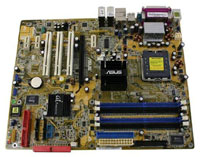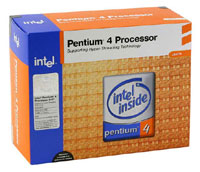Buyer's Guide - Mid-Range, January 2005
by Jarred Walton on January 21, 2005 11:09 AM EST- Posted in
- Guides
Intel Motherboard and CPU Recommendations
The Intel side of things is a little less difficult to assess. There haven't been any major developments lately that are due to upset the balance, so things remain largely unchanged. The impending launch of the 600 series processors will hopefully breathe some new life into the platform. With the lowest clocked models scheduled to run at 3.0 and 3.2 GHz and targeting a reasonable $200-$300 price according to recent Intel roadmaps, the Prescott 2M is definitely something to think about if you're not in any particular hurry. The additional L2 cache should boost performance to beyond current Pentium 4 Extreme Edition levels - the L2 cache is faster than L3 cache, remember - and given the much lower pricing of these mainstream oriented processors, it seems unwise to make a large investment in a high-end Pentium 4 right now. In the Mid-Range, however, price/performance is not likely to be dramatically different from current options, with an extra 10% to 15% performance coming from the cache upgrade. Waiting a few months for a 10% performance increase is just delaying the inevitable, so here is our Intel suggestion.
 |
 |
| Click images to enlarge. | |
Intel Platform Recommendation
Motherboard: ASUS P5GD1 (915P)Price: $116 Shipped
Processor:Pentium 4 540 (3.2 GHz) for 775 (Retail)
Price: $215 Shipped
While we haven't given the P5GD1 [RTPE: ASUS 915P P5GD1] a formal review, it shares many similarities with the Gold Editor's Choice P5GD2 from our 915P motherboard roundup. We chose the "lesser" board for a couple of reasons. First is price, with the P5GD2 generally costing $30 more than its little brother. The bigger factor also plays into price: the P5GD1 uses DDR RAM instead of DDR2. DDR2 continues to cost quite a bit more than regular DDR memory, and it has yet to show a tremendous performance advantage. Unlike the AMD options, there really doesn't seem to be any point in avoiding PCI Express on the Intel platforms, as you would have to opt for an older chipset and fewer features in order to go that route. This can be good or bad, depending on the graphics card that you plan on using, but we'll get to that topic shortly.
As far as features go, the ASUS board has pretty much everything that you could want. The integrated gigabit Ethernet (GbE) is on the PCI Express bus, so performance is not limited by the slower PCI bus. That really doesn't seem to matter too much, however, as nearly all GbE setups that we've tested can handle 30 to 40 MB/s transfer rates, which is usually as fast as any non-RAIDed hard drive setup. Only serious networking types are likely to be concerned with maximum GbE performance. One minor shortcoming is that unlike the P5GD2, ASUS decided to use a cheaper non-HD audio solution. We would have preferred the Azalia HD solution, but the Realtek ALC861 8 channel audio is plenty good. If you plan on adding your own sound card, this becomes a moot point, but we certainly don't feel that better sound hardware is necessary.
For the processor, we try to keep things relatively close to the price and performance of the AMD system by going with the 3.2GHz Pentium 540 [RTPE: BX80547PG3200E]. We actually end up being slightly cheaper than the AMD platform here, due to the lower cost of the motherboard, but overall, the AMD system will often outperform the Intel system, so that seems fair. There are still areas where Intel leads in performance, most likely due to better optimizations for their architecture; so if gaming isn't your primary concern, it becomes more of a toss up. A slight upgrade in performance via the P4 550 is also something to consider, but for a $60 price increase, you only get an extra 200MHz, so it's not a great bargain.










46 Comments
View All Comments
JarredWalton - Friday, January 21, 2005 - link
Rand - That doesn't surprise me too much, given our recent article showing that the NF4 Ultra and NF4 SLI are the same chip with a tweaked package. I would guess there's a reasonable chance the NF4 4X is the same as well, with other modifications to the package. As far as I know, what I put about their difference is the "official" NVIDIA stance. If the 4X is just the "validated" version... well, not a big deal, really. I'll modify the text a bit to reflect this.KristopherKubicki - Friday, January 21, 2005 - link
N3cr0: The nForce4 board you mentioned is not shipping yet.Kristopher
Jep4444 - Friday, January 21, 2005 - link
I think the Asus A8V Deluxe would of been a better motherboard recomendation than the MSI K8N Neo2 Platinum. The Asus board is pretty much the best 939 AGP board out and it costs less than the MSI aswell.Avalon - Friday, January 21, 2005 - link
'Samsung calls the 997DF a "perfectly visually flat" tube. What they really mean is that the surface of the glass is perfectly flat, but the inside of the glass is very slightly curved. Most people will never notice it, but we feel that in the interest of full disclosure, it should be mentioned'Yes. Thank you for pointing that out, Jared. I purchased this monitor about a month ago, and noticed it right upon powering it up. No matter how much you adjust the geometry, there is always a slight curve. I was so angry at one point I was either going to hit it with a bat or return it. Now I've just learned to deal with it, and I'm no longer really bothered by it.
Rand - Friday, January 21, 2005 - link
Slight addendum to my above post-I just tried nVidia's hardware firewall.. it's working fine.Apparently that also runs on the basic nForce4.
Rand - Friday, January 21, 2005 - link
Slight addendum to my above post-I just tried nVidia's hardware firewall.. it's working fine.Apparently that also runs on the basic nForce4.
Rand - Friday, January 21, 2005 - link
"The difference, if you recall, is that the Ultra has an unlocked HyperTransport multiplier and will generally offer more in the way of overclocking, while the 4X is locked at a 4X HyperTransport multiplier (800 MHz)."I believe that's since been proven false.
There are a couple threads in the Motherboards forum about overclocking on said board, and I haven't seen anyone comment on any difficulties adjusting the HTT.
My own board is running at 300x3 HTT (900MHz HTT) right now. (Adjustable from 2-5X), though it did need +0.2V to the chipset to run stable at 1000HTT.
The differences right now between the NF4 and NF4 Ultra would appear to be 3Gb/s SATA vs. 1.5Gb/s SATA, and official support for 1000HTT vs 800HTT.
As well as not supporting nVidia's firewall.
geogecko - Friday, January 21, 2005 - link
Where are all the nForce4 Ultra (non-SLI) boards? Really looking forward to ASUS A8N-E Premium, but no news, except that some have said this board will never exist?!Gage8 - Friday, January 21, 2005 - link
I don't know, this guide just confirmed for me that now is not the time to buy if you want stability and upgradability (new word?).Nforce2 taught me not to buy revision 1.x...so lesson learned, bring on Nforce4 revision 2.x.
N3cr0 - Friday, January 21, 2005 - link
Just curious why the MSI K8N Neo4 Platinum/SLI wasn't put in as an SLI board for the AMD choices. It seems to be lower price then the Asus board. I'm going to get one of the two boards and can't really figure out what the differences are aside from some networking items. (That and the HyperTransport which I dont get at all)